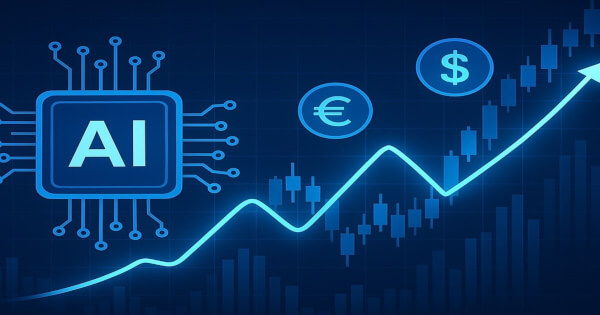The AI Revolution in Forex Trading: A New Era of Efficiency and Strategy
By Khushi V. Rangdhol
Published on April 9, 2025
The impact of artificial intelligence (AI) on forex trading is nothing short of transformative. With algorithms now executing a staggering 70-75% of trades, human traders have shifted their focus from manual execution to strategic oversight in a market that moves at breakneck speed. In this new paradigm, trading is less about sheer execution and more about calculated moves and insights.

The Rise of Algorithms
According to the Bank for International Settlements (BIS), the integration of algorithmic and electronic trading systems in spot forex markets is on the rise. As of 2022, approximately 70-75% of spot trades at leading financial institutions are conducted through automated platforms. This shift reflects a broader adoption of AI-driven trading strategies, particularly among banks and non-bank financial entities.
One of the standout features of these systems is their capacity to optimize trade execution by breaking down large orders into smaller transactions. This reduces the risk of price slippage and allows for rapid response to market signals. While claims of execution costs dropping by 23% and error rates plummeting to 0.03% attract attention, there’s growing evidence that AI is indeed minimizing inefficiencies and automating many of the risks traditionally associated with manual execution.
Speed: The New Currency of Forex Trading
The most significant change wrought by AI is its exceptional speed in reacting to market news. Although precise figures may vary, high-frequency trading systems are known to execute trades in fractions of a second—often in less than one-tenth. Algorithms now analyze economic releases and price fluctuations instantaneously, adjusting positions within moments.
As a result, the average duration of AI-powered forex trades has shrunk to mere seconds. Where human traders might have held onto positions for hours or even days, modern systems are designed to execute and exit based on real-time data. This high-speed trading environment improves efficiency and liquidity but also raises the bar for human traders who struggle to compete solely on execution speed.
The Evolving Role of Traders
Contrary to fears that AI would render human traders obsolete, the reality is quite the opposite—human roles are evolving. Traders are now acting more as algorithm managers and risk engineers, devoting less than a third of their time to actual trade execution. Instead, they focus on strategy, compliance, and overseeing automated systems. This shift means that human expertise is still invaluable—especially during volatile or illiquid market conditions where experienced judgment can surpass algorithmic predictions.
Moreover, as trading strategies integrate AI tools, traders are learning to leverage data analytics for better decision-making. At Extreme Investor Network, we believe that the ability to interpret data and understand market context will separate successful traders from the pack.
Regulatory Landscape Adaptations
As the influence of AI in trading grows, regulatory entities are stepping up their oversight to ensure market stability and transparency. In early 2025, the Hong Kong Securities and Futures Commission implemented regulations that require firms to evaluate AI-driven models under various conditions while maintaining human oversight. Similarly, the UK’s Financial Conduct Authority has highlighted the need for governance and accountability in algorithmic trading.
The European Union is also taking steps to implement MiFID III reforms and an upcoming AI Act, which classify trading algorithms as "high-risk" systems. These regulatory frameworks aim to foster innovation without sacrificing market integrity, requiring transparency, documentation, and robust safeguards.
A Collaborative Future: Human-AI Synergy
The integration of AI into forex trading is not about replacing human judgment with machine execution; it’s about forging a powerful partnership between the two. The most competitive firms recognize the importance of this human-AI synergy: utilizing algorithms for efficient execution while retaining a strong focus on governance and risk management.
As this quiet revolution continues to unfold, it’s transforming the forex landscape—from trade execution methods to the very nature of trading roles. With the right approach, traders can leverage AI’s strengths while relying on their intuitions and strategies for sustained success.
At Extreme Investor Network, we strive to equip our readers and investors with the insights and tools necessary to thrive amid these rapid changes. Stay tuned as we explore more about how you can take advantage of the evolving landscape of forex trading and strategic investment opportunities in the world of cryptocurrency.
Image source: Shutterstock
For further insights into the world of cryptocurrency and investment strategies, don’t forget to subscribe to Extreme Investor Network and be part of the revolution in digital finance!

